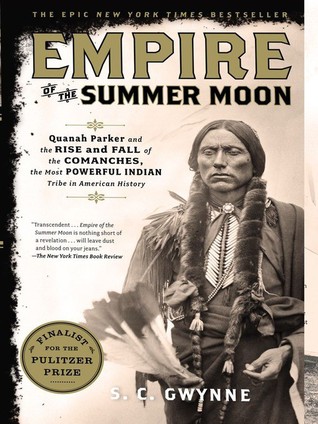More on this book
Community
Kindle Notes & Highlights
by
S.C. Gwynne
Read between
December 13, 2019 - January 5, 2020
Quahadis were the hardest, fiercest, least yielding component of a tribe that had long had the reputation as the most violent and warlike on the continent; if they ran low on water, they were known to drink the contents of a dead horse’s stomach, something even the toughest Texas Ranger would not do.
But in 1836 the only borderland where white civilization met hostile Plains Indians was in Texas. Oklahoma was pure Indian territory, a place where beaten tribes of the South and middle Atlantic states were being forcibly relocated, often right on top of warlike plains tribes.
At one point James’s group went thirty-six hours without food, finally eating only after he managed to catch and drown a skunk.
main reasons Mexico had encouraged Americans to settle in Texas in the 1820s and 1830s was because they wanted a buffer against Comanches, a sort of insurance policy on their borderlands. In that sense, the Alamo, Goliad, San Jacinto, and the birth of the Texas republic were the product of a misguided scheme to stop the Comanches. No one knew this, either. Certainly not settlers like the Parkers who were, in effect, being offered up as meat for Comanche raiders.
making moral judgments about the Comanches. The torture-killing of a defenseless seven-week-old infant, by committee decision no less, is an act of almost demonic immorality by any modern standard. The systematic gang rape of women captives seems to border on criminal perversion, if not some very advanced form of evil.
If warriors were on the trail and short of water, they might drink the warm blood of the buffalo straight from its veins. Entrails were sometimes eaten, stripped of their contents by using two fingers. (If fleeing pursuers, a Comanche would ride his horse till it dropped, cut it open, remove its intestines, wrap them around his neck, and take off on a fresh horse, eating their contents later.)
The trouble started around 1650. That was when various bands of the Apache tribe, newly mounted on Spanish horses and bristling with hostility, began raiding the New Mexican settlements. Nothing the Spanish had seen or experienced in Mexico prepared them for these attacks. That was not because they were defenseless. Their soldiery consisted of heavily mounted dragoons equipped with steel-plated armor; large-caliber, muzzle-loading harquebuses and miquelets, pikes, and gleaming sabers. Though to our modern eyes they may have looked a bit comical, they were in fact perfectly equipped to fight
...more
14 If the Comanches stood as a seemingly impenetrable obstacle to Spanish expansion, they also offered a guarantee that the French and English would not pass, either. The French had pursued an entirely different colonial policy, eschewing outright conquest in favor of influence-peddling, alliance-making, and a sort of mercantile diplomacy—most importantly involving weapons but other commodities, too—by state-sponsored traders, often with great effect. The
(So many raids were made by moonlight that in Texas a full, bright spring or summer moon is still known as a Comanche Moon.)
They dismounted and prepared to fight. In a fight with Comanches, dismounting on open ground was like signing your own death warrant. Men on foot against mounted men moving at 20 or 30 miles per hour who could shoot twelve arrows in the time it took to reload a rifle and fire it once was not a fair fight. It
They were almost all in their twenties, and they came to San Antonio looking for something other than a comfortable, sedentary life on a farm. They liked the idea of killing Comanches and Mexicans. Most of the famous Ranger captains had completed their careers by the time they were thirty-two. They had no property other than their horses and often no steady jobs. Without them, the idea of ranging companies would never have worked.
Ranger John Caperton estimated that “about half the rangers were killed off every year” and that “the lives of those who went into the service were not considered good for more than a year or two.”23 He also wrote that, of the one hundred forty young men in San Antonio in 1839, “100 of them were killed in various fights with Indians and Mexicans.”
As Dixon recalled, “some of the boys suggested that I try the big ‘50’ on them. . . . I took careful aim and pulled the trigger. We saw an Indian fall from his horse.”41
what Comanche men would find to do with themselves if there was no hunting or fighting and no way to prove their worth.
“The white man goes into his church and talks about Jesus, but the Indian goes into his tipi and talks to Jesus.”


